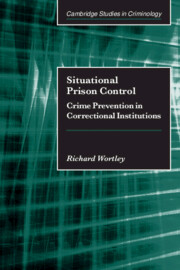Book contents
- Frontmatter
- Contents
- List of figures and tables
- Foreword
- Acknowledgements
- Part I Theoretical foundations
- 1 Introduction: why situational prison control?
- 2 Situational theories of prison behaviour
- 3 Situational methods of prison control
- 4 A model of situational prison control
- Part II Specific behaviours
- List of references
- Index
3 - Situational methods of prison control
Published online by Cambridge University Press: 22 September 2009
- Frontmatter
- Contents
- List of figures and tables
- Foreword
- Acknowledgements
- Part I Theoretical foundations
- 1 Introduction: why situational prison control?
- 2 Situational theories of prison behaviour
- 3 Situational methods of prison control
- 4 A model of situational prison control
- Part II Specific behaviours
- List of references
- Index
Summary
Prisons are in the business of control. From the time that the first true prisons were built in the late eighteenth century, prison administrators have been faced with the fundamental problem of how to manage safely and contain securely large numbers of people who have been confined in a restricted space against their will. For the most part, maintaining control has been seen as an uncomplicated matter involving little more than building higher walls and devising more repressive regimes to crush prisoner resistance. Only recently have some of the theoretical insights discussed in the previous chapter been consciously applied to the problem of prison control. However, while prison control strategies have not as a rule been directly fashioned by the theoretical debates about situational prevention, methods of prison control are readily amenable to analysis in situational terms. In many ways, prison control has always and unavoidably been situational.
This chapter describes the various methods of prison control and relates these methods to the theories of situational behaviour outlined in chapter 2. There are three basic situational elements in prison that can be manipulated in an effort to control the behaviour of prisoners – the physical environment of the prison, the characteristics of the prison population and the regimes and strategies put in place to manage the population in that environment.
Control and the physical environment
The physical environment of the prison includes the design and layout, the building style, construction materials, furnishings and security hardware.
- Type
- Chapter
- Information
- Situational Prison ControlCrime Prevention in Correctional Institutions, pp. 36 - 54Publisher: Cambridge University PressPrint publication year: 2002



